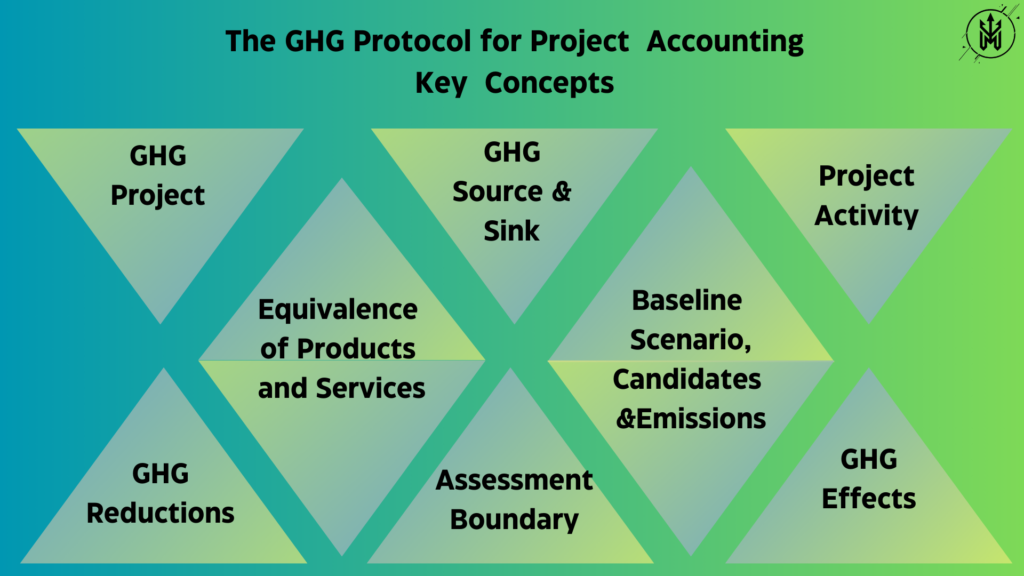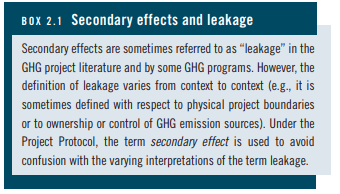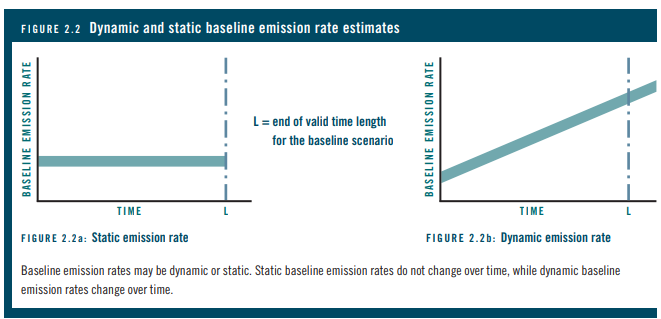
A number of key concepts must be understood to account for GHG reductions from GHG projects. This blog explains the importance of these concepts and describes how and where they are used in Project Protocol.
GHG Project
A GHG project is a specific action or a series of actions designed to do one of three things:
- Reduce Greenhouse Gas (GHG) Emissions: This means trying to release less of the gases that contribute to climate change.
- Increase Carbon Storage: This involves finding ways to store more carbon, which helps in balancing the amount of carbon in the atmosphere.
- Enhance GHG Removals: This is about improving methods to take GHGs out of the air, also contributing to mitigating climate change.
Project Types:
- A GHG project can stand alone, meaning it’s its own thing.
- It can also be a part of a larger project that might not be directly related to greenhouse gases, like a broader environmental initiative.
- A GHG project can involve one or more specific actions.
Project Activity
A project activity is a specific thing you do to try and change the levels of greenhouse gases (GHGs) in the air. This could be changing how you make something, how you use energy, or even how you manage a process. It’s like a targeted action meant to have a positive impact on the environment.
- Examples of Project Activities:
- Changing how something is produced.
- Modifying how energy is used in a process.
- Adjusting how a service or delivery is done.
- Introducing a completely new system to replace an old one.
- Importance of Identifying Project Activities: It’s really important to properly figure out and describe what you’re doing in your project. This helps in understanding how much your actions are helping to reduce GHGs.
- Determining GHG Reductions:
- For each project activity, you figure out how much it’s reducing the greenhouse gases.
- The guideline ‘Project Protocol’ explains how to calculate or measure these reductions for each individual thing you’re doing.
- Total GHG Reductions for the Whole Project: If your project involves more than one activity (which it often does), you add up the reductions from each activity to get the total benefit of the whole project.
GHG Source/Sink
A GHG source is any process that releases GHG emissions into the atmosphere. Under the Project Protocol, there are five general GHG source categories:
- combustion emissions from generating grid connected electricity;
- combustion emissions from generating energy or off-grid electricity, or from flaring;
- industrial process emissions—e.g., carbon dioxide (CO2) from the production of clinker for cement;
- fugitive emissions—e.g., GHG leaks from pipelines; and
- waste emissions—e.g., GHG emissions from landfills.
A GHG sink is any process that removes and stores GHG emissions from the atmosphere. The Project Protocol identifies one GHG sink category: increased storage or removals of CO2 by biological processes.
The GHG sources and sinks affected by a project activity must be identified to determine the project activity’s GHG effects , and to specify how emissions from GHG sources and sinks affected by the project activity will be monitored.
GHG Effects
GHG effects refer to the changes in greenhouse gas (GHG) emissions, removals, or storage caused by a project activity. In other words, it’s about how the project influences the gases that contribute to climate change.
Two Types of GHG Effects:
- Primary Effects:
- Definition: The main, intended change caused by the project activity in GHG emissions, removals, or storage related to a GHG source or sink.
- Each Project Activity Has One: Normally, each thing you do in your project will have a single main impact.
- Relative to Baseline Emissions: This primary effect is measured by comparing it to the baseline emissions, which are the emissions without the project.
- Secondary Effects:
- Definition: Unintended changes caused by the project activity in GHG emissions, removals, or storage related to a GHG source or sink.
- Typically Small: These changes are usually smaller compared to the main, intended impact of the project activity.
- Two Categories:
- One-time effects: Changes that happen during the construction, installation, establishment, decommissioning, or termination of the project.
- Upstream and downstream effects: Ongoing changes in emissions related to the materials going into the project (upstream) or the products coming out of the project (downstream). Some of these changes might be influenced by market responses to changes in supply and demand.
- Significant Secondary Effects: Only important or significant unintended changes need to be closely watched and measured under the Project Protocol. Whether a secondary effect is considered significant depends on how big it is compared to the main effect and the specific circumstances of the project.

GHG Assessment Boundary
- The GHG assessment boundary is like a “scope” that includes all the main and important effects directly and indirectly connected to the GHG project.
- If a GHG project involves multiple activities, the assessment boundary considers the effects of all those activities.
- It helps to figure out where the greenhouse gases come from (sources) and where they go (sinks) so that the project’s impact can be measured.
Not a Physical or Legal Boundary:
- The GHG assessment boundary is not a physical or legal limit like a fence or a property line.
- It’s not about where the project is physically located or who legally owns or controls it.
Primary and Secondary Effects:
- Primary effects are the main impacts directly related to the GHG project.
- Secondary effects are important consequences that happen as a result of the primary effects.
Consideration of Effects: All the primary and significant secondary effects, whether they happen close to the project or at sources/sinks owned by the project participants, are considered within the GHG assessment boundary.
No Need for a Specific Project Boundary: According to the Project Protocol, there’s no requirement to define a specific project boundary based on the physical size of the GHG project or what is owned or controlled by the project participants.
GHG Reductions
GHG reduction in the protocol means either:
- Decreasing the amount of greenhouse gases emitted into the atmosphere.
- Increasing the amount of greenhouse gases removed from the atmosphere or stored (like in plants or soil).
This is compared to the baseline emissions, which is the amount of greenhouse gases that would have been emitted without the project.
Quantification of GHG Reductions:
- The total GHG reductions from a project activity are calculated by adding up the GHG reductions caused by its primary effect(s) and any significant secondary effects.
- This calculation takes into account both decreases and countervailing increases in GHG emissions (some things might produce more emissions, but the project offsets that by reducing emissions elsewhere).
For the entire GHG project, the total GHG reductions are the sum of the GHG reductions from each project activity.
Baseline Candidates
Baseline candidates are alternative technologies or practices, within a specified geographic area and temporal range, that could provide the same product or service as a project activity. The identification of baseline candidates is required to estimate the baseline emissions for the project activity. Baseline candidates are identified for each project activity in Chapter 7 of GHG Project Protocol, which includes guidance on how to define an appropriate geographic area and temporal range.
Baseline Scenario
- Baseline Scenario in Climate Change Mitigation:
- The baseline scenario is like a “what would have happened without the project” situation.
- It’s a made-up description of what was likely to occur if nobody considered doing anything to reduce climate change effects.
- Purpose of the Baseline Scenario: The baseline scenario helps estimate something called “baseline emissions.” This is the amount of greenhouse gases that would have been released into the environment if there were no efforts to mitigate climate change.
- Three Generic Possibilities for Baseline Scenario: There are three basic ways to imagine what might have happened without the project:
- Same Technologies or Practices: Assuming that the project uses the same methods or technologies that would have been used anyway.
- Baseline Candidate: Considering a scenario where an alternative approach could have been chosen instead of the project.
- Continuation of Current Activities: Assuming that everything would just keep going the way it was, producing the same kind and amount of product or service.
- When is Baseline Scenario Identified:
- The baseline scenario is explicitly identified only when a specific procedure, called the project-specific baseline procedure, is used to estimate baseline emissions.
- If a different procedure, the performance standard baseline procedure, is used, then baseline emissions are estimated without specifically naming a baseline scenario.

Baseline Emissions
GHG reductions from a project activity are quantified relative to baseline emissions, which refers broadly to baseline GHG emissions, removals, or storage. Baseline emissions associated with primary effects are derived from either a baseline scenario or a performance standard. Baseline emissions associated with secondary effects will be linked to the project-specific baseline scenario. If the performance standard procedure is used, baseline emissions associated with secondary effects are inferred from baseline candidates or are estimated conservatively.
Baseline Procedures
Baseline procedures are like methods or ways to figure out how much pollution or greenhouse gas emissions we would normally expect before a specific project starts. These procedures are described in something called the Project Protocol, which is like a rulebook for these calculations.
Now, there are two ways to estimate these baseline emissions:
- Project-specific procedure: This method figures out the baseline emissions by looking at the specific details of the project. It identifies a baseline scenario, which is like a detailed plan of what would happen if the project didn’t exist. This plan is made by analyzing the project and its alternatives (other ways of doing things). The emissions calculated using this method are only valid for the specific project being looked at.
- Performance standard procedure: This method estimates baseline emissions by using a standard emission rate. This rate is calculated by analyzing the emissions of all similar projects. It’s like having a benchmark or a standard that can be used for many projects of the same type. So, instead of creating a specific plan for each project, we use this standard to estimate emissions. This procedure is also known as a multi-project baseline or benchmark.
Valid Time Length for the Baseline Scenario
When we’re trying to predict what might have happened in the future (like how much pollution a project might cause), the further into the future we go, the more uncertain our predictions become. It’s a bit like trying to predict the weather for next month versus predicting it for tomorrow – the farther out you go, the less accurate you’re likely to be.
Because of this uncertainty, the plan or standard we use to estimate pollution should only be considered valid for a certain amount of time. After that time, either the project has already achieved all the expected pollution reductions it can, or we need to come up with a new plan or standard.
How long this time period is can vary. It depends on things like the technology being used and the rules or policies in place. Think of it like setting a deadline for a project – the baseline scenario or performance standard is only good until that deadline. Once the deadline is reached, we might need to update our plan or standard to better reflect what’s happening.
Dynamic Versus Static Baseline Emission Estimates
When we want to figure out how much pollution a project might cause, we often use something called an “emission rate.” This rate connects the amount of greenhouse gas emissions to either the production of a product or service or a specific time period.
Now, these emission rates can be either “static” or “dynamic.”
- Static emission rates: Imagine this like a fixed number that doesn’t change over time. It’s best for projects where things stay pretty much the same for a while. For example, if a new project is replacing an old one and we think the basic way it operates won’t change much, a static emission rate is suitable.
- Dynamic emission rates: Picture this as a number that can change over time. It’s useful when a project is part of a system that’s expected to change a lot. For instance:
- Electricity supply projects: If a project involves producing electricity and the sources of that electricity are expected to change significantly over time, a dynamic emission rate is more appropriate.
- LULUCF projects: This stands for Land Use, Land-Use Change, and Forestry projects. If a project involves trees and the amount of carbon they store changes as the trees grow, a dynamic emission rate makes more sense.

Equivalence of Products and Services
Imagine a project that makes and sells something, like a product or service. Now, every project is part of a bigger market where similar things are bought and sold. So, if our project didn’t exist, we should assume that the market would still provide a similar amount and quality of those products or services that our project would have made.
This assumption is especially true when the project is small compared to the whole market. In other words, if our project is so tiny that its presence or absence doesn’t really change market prices, then we can safely assume that the market would have carried on as usual.
Now, this idea of equivalence is important when we’re trying to measure how much the project helps reduce greenhouse gas emissions.
Here are a few examples to understand it better:
- Identifying secondary effects: If the project reduces the production of something, the market will step in and provide the same amount as if the project never existed. This might lead to other effects we need to consider.
- Identifying baseline candidates: When choosing what to compare our project to (baseline candidates), we should pick things that can provide the same quality of products or services as our project. If we’re using a specific method to estimate baseline emissions, the candidates should also be able to produce the same quantity.
- Estimating baseline emissions: When figuring out how much pollution our project might save, we assume that the market would produce the same amount and quality of stuff as our project, had it not been there.
There are some cases where this assumption might not hold. For example, if the market for the project’s products or services doesn’t work well, or if the project is so big that it could change market prices, causing a different total quantity to be produced. In these cases, the developers need to explain why the assumption of equivalence doesn’t apply.
Additionality
The basic idea is to count only the GHG reductions that are truly extra or different because of the project. Sometimes, a project might have happened anyway, even without special efforts to be environmentally friendly. In such cases, the project and the baseline (what would have happened without the project) are effectively the same.
It’s important to only count GHG reductions that are truly additional to the baseline, and this concept is known as “additionality.”
Two Approaches to Additionality:
- Project-Specific Approach: Tries to find a unique baseline scenario for each project. The thinking is that if you can clearly identify a baseline, you can easily see if the project is different or additional. However, since finding a baseline is not always straightforward, some suggest doing additional tests to be sure.
- Performance Standard Approach: Instead of looking at each project individually, this approach sets a standard performance level. If a project’s GHG emissions are lower than this standard, it’s considered additional. This is a more consistent way, especially when dealing with many similar projects, and it avoids the complexity of figuring out individual baseline scenarios. The challenge is setting the performance standard at a level that ensures only truly additional GHG reductions are counted.


